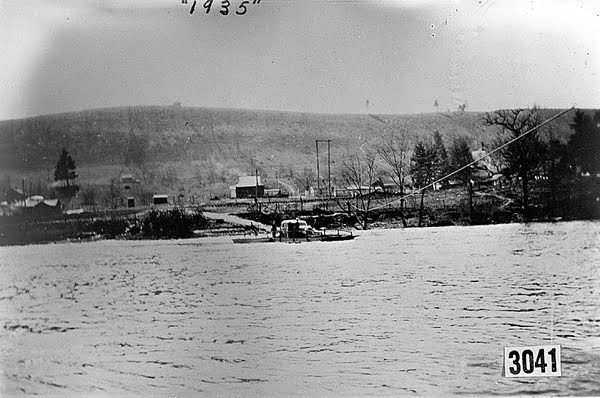
Above, the Seebert Ferry, photo taken in 1935.
Ken Springer
Watoga Foundation
Contributing Writer
The first time I heard the words “Watoga State Park,” I was sitting on the porch of Harper’s General Store in Seneca Rocks, West Virginia – now called Mouth of Seneca. I was talking to Buck Harper*, the proprietor of this historic store that still had a single hand-crank gasoline pump out front.
In the colder months, the store served as a Saturday night gathering spot where local gents played cards on the butcher’s block while a cheery fire burned in an old potbellied stove.
As a regular rock climber at Seneca Rocks, I got to know Buck as a man of great wit, whose musings were greatly enjoyed by the climbing community. His “country boy” affectation belied the fact that he was a graduate of Davis & Elkins College, and one of the sharpest and funniest men I have ever known.
One time a big RV, towing a jeep in which there were two bicycles, pulled in at the store. On top of the RV was an aluminum canoe strap-ped to the railing, and there was a dirt bike mounted on the front bumper.
A gentleman from New York stepped out of the RV and Buck, not saying a word, slowly made his way around the vehicle, examining all of the means of transportation attached to it. After circling the rig, he looked at the owner and said, “I do not know where you are headed, sir, but you sure do plan to get there.”
The New Yorker chuckled and asked Buck how to get to Watoga State Park.
In his usual style, Buck put his hand to his chin, appearing to be in deep thought for a few moments, then said, “I don’t think that you can get there from here.”
Well, Buck went on to give the man directions to our park, but there were times in Watoga’s history when Buck’s comical remark was reasonably accurate.
Today’s access to the park is a result of continual improvement initiated by the CCC, but in Watoga’s early years it was mainly restricted to a route that took visitors through Huntersville and into the park by way of Beaver Creek Road.
Many, if not most, of today’s visitors to Watoga State Park enter the park through the village of Seebert** where a modern bridge offers a safe and convenient crossing of the Greenbrier River. Such was not the case for much of Watoga’s 82-year history.
Before the first bridge was constructed in Seebert in 1965, this community, like many in the Greenbrier River corridor, used natural fords for crossings. Some enterprising folks offered “boats for hire” and ferry services, which, unlike the natural fords, were less dependent on a narrow range of water levels.
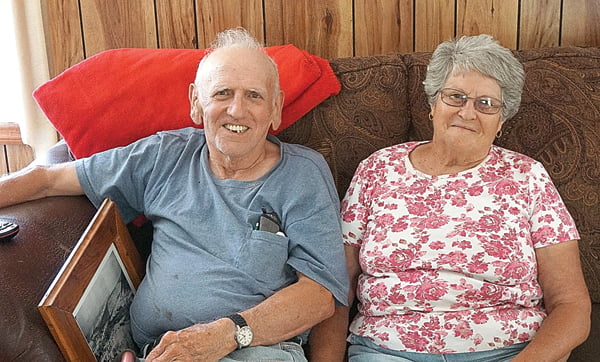
To get the lowdown on the Seebert area, I needed only to stop at the home of neighbors Curtis and Irene Pyles.
Curtis is a lifelong resident of Seebert. He grew up on the family farm located just across the river. Curtis has an encyclopedic knowledge of Seebert and the surrounding area.
Curtis and his lovely wife, Irene, recently sat down with me to share many delightful stories about the relationship between the village of Seebert and the Greenbrier River.
Curtis was quick to point out that the Seebert you see today is nothing like the Seebert of railroad days.
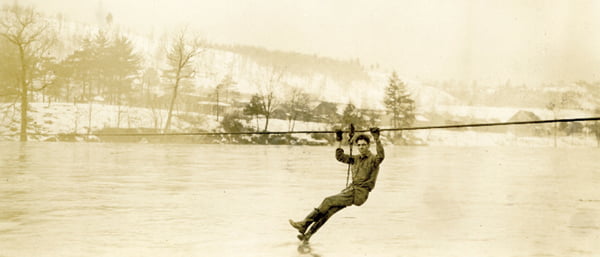
A visitor to Seebert back then would see trains stopping at the depot, located near the present day Jack Horner’s Corner. There was a post office, several stores, a gas station and a Presbyterian and Methodist Church. The Pleasant Green Church can still be seen on Seebert Lane just outside of town, as well.
Before there were any over-water bridges, Curtis, like his siblings before him, would pole a boat across the river from their farm to a spot just above where Stamping Creek joins the Greenbrier. He would tie the boat there and walk the railroad tracks down to the Seebert Depot, where the local children waited for the school bus to take them to Hillsboro. Curtis fondly remembers that there was a coal burning stove in the depot; a welcoming warmth on cold winter mornings.
Seebert had several low-water fords over the years, but a ferry came to Seebert in the early 1930s. Fred Barton, a veteran of World War I, was employed as a ferryman for the CCC Camp Seebert, located near Cabin 1 in Watoga State Park.
The ferry service came to a tragic end when Barton attempted a crossing with six or seven passengers on board on May 7, 1935. The river that morning was seven feet above flood stage. The rope that tethered the ferry to the cable broke, causing the boat to overturn dumping the passengers and Captain Barton into the swollen and fast-moving Greenbrier River. Ironically, everybody made it to shore but Barton, who was unable to swim.
A low-water bridge, remembered fondly by many park visitors and locals, was built in 1948. The concrete structure spanned the river a couple of hundred yards downstream from the existing bridge.
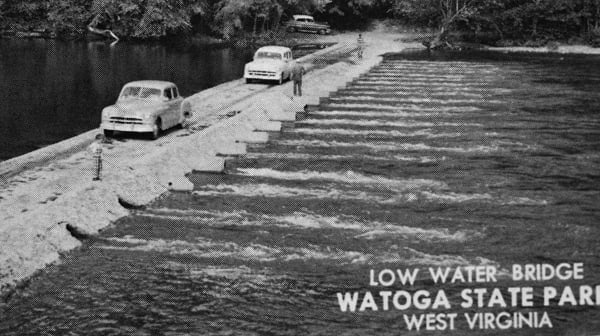
Postcard picture of the old low-water bridge in Seebert.
Vehicles crossing this low-water bridge would drive up on the island for a short way where a shorter section of similar construction bridge traversed the lagoon and onto the park entrance road.
The state built the first modern bridge in 1965; Curtis explained that this structure was suspended on concrete piers and was decked with treated two by fours, laid horizontally on the two-inch side across the width of the bridge. The bridge was washed away by the great flood of 1985, also known as The Killer Flood.
At this point, Seebert found itself once again cut off from the other side of the river. Residents who lived over there had to drive through the park to gain access to Beaver Creek Road, and then on to other destinations.
For a brief period, park visitors had to revert to using the same route used during the CCC Camp Watoga days – that being Beaver Creek Road from Huntersville.
In a matter of weeks though, bulldozers and heavy equipment arrived in Seebert to build a temporary ford across the Greenbrier just downstream from the tattered remnants of the old low-water bridge. This crossing was used until the new bridge was completed in November of 1986.
And now, barring high water the likes of which this state saw in November of 1985, Watoga State Park is just a scenic drive away.
Though the old low-water bridge in Seebert now consists of just a few tattered remnants of its original design, it still draws people by foot, bicycle, and canoe, to stop and sit a spell there. I know that because I too enjoy sitting on the concrete section that is attached to shore on the Seebert side of the river.
It is adjacent to the Greenbrier River Trail and a peaceful place to sit, listening to the gurgling water and contemplating any number of things, both great and small. It wouldn’t take a great deal of imagination to see a young C. Lee Jarvis furiously pedaling his bike through the moving water trying to get to the other side just for the challenge of it. That bridge holds many fine memories within its structure.
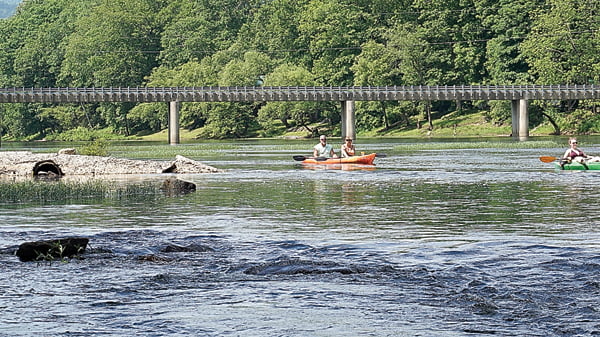
Canoeists paddling by a remnant of the low-water bridge in Seebert with the new bridge in the background.
You can imagine what a big adventure crossing the Greenbrier River on the low-water bridge would have been for a child. Here are some memories from park visitors and local folk, in their own words:
“I lived in Seebert when the low water bridge was constructed. It was so exciting to watch it being built. They channeled the water to one side while they built half and then reversed the flow. I was ten years old at the time. I once tried to ride my bicycle across when high water was going over the bridge. Got about halfway across and then struggled to get back to the side. It was a much-appreciated bridge.” ~ C. Lee Jarvis
“As a girl, when we traveled to see relatives we would cross the low water bridge until the new bridge was built. I always loved the ride through the park during the summer months – it was cool due to all the shade and the lovely brook and the breeze in the trees was such a calming, whispery, soothing sound. I am now 60, and I remember it as clearly as if it was yesterday. We also washed our cars when the water was low – or we could ford the river in places.” ~ Susan Dean
“In 1958, three couples of the Spencer clan rented the three cabins on Droop Mountain in August to attend the Hinkle family reunion and visit aunts, uncles and cousins. That’s the first time we crossed the bridge to go for the afternoon at the pool with the kiddies. An addendum to the story: in the spring of the year, we welcomed three new babies to the family!”~ Shirley Spencer.
(Readers: Is Shirley suggesting some connection between the bridge and the arrival of three babies nine months later? There may be more to that low-water bridge than we thought).
“I remember when the bridge was broken. I had a 79 Ford Bronco with oversized tires. This was in the 80s. My wife and kids were with me on a trip to our beloved Watoga. I told them we were going to ford the river near the bridge. My wife and daughter were very skeptical, but my son and I were going for it. I put the Bronco in low range 4-wheel drive, and we eased our way across the river. What a wonderful experience. Love the Watoga area.” ~ Harold Spangler
“My father told me that one time in the 1950s there were several fishermen on the low water bridge with a few inches of water coming over the bridge. That was the best time to fish for red-eyes (rock bass). A man from Seebert and his two sons were drunk and drove across the bridge splashing water on the fisherman and laughing about it. When they came back across the bridge, the fisherman stopped the vehicle, pulled them out of the car and threw them all in the river. When I was young I often remember seeing the bridge completely lined with fishermen when the red-eyes were hitting. The tannery in Marlinton had a lot to do with the number of red eyes in the river. Once the tannery shut down the fishing declined, but I am sure the water quality improved.” ~ Sollie Workman
“I have a camp on the Watoga side of the Greenbrier River directly across the river from Jack Horner’s Corner. For several months after the Flood of 1985, due to the car bridge being destroyed, my neighbors and I had to access our camps by traveling Rt. 219 north to Marlinton, east to Huntersville and through Watoga from the north entrance. Sometime in the summer of 1985 someone carved a low water passage through the Greenbrier River about 100 yards down river from the destroyed bridge. We had to travel downriver on the Greenbrier River Trail and descend down a graded path on the riverbank and drive through the river right beside the previously destroyed Low Water Bridge to get to the east side of the river and the Watoga entrance road. You would either turn right to enter the park or turn left to go to our camps on the east side. I believe the destroyed bridge was replaced during the summer-fall of 1986, and the temporary path through the river was removed.” ~ David L. Brown
“We used to go to the Low Water Bridge a lot; that was our Sunday thing to do. Us kids would swim and my stepfather would fish. We would bring a picnic lunch and eat on the bridge. Good memories. The new bridge named for our good friend and neighbor Tom Edgar was a welcome change though. I also have a picture of the old bridge during the 1985 flood where it had taken the bridge and laid it across the river bank, the whole rail. I will do some digging. I enjoy your writings.”~ Susan Hefner Kershner.
“Dad took me fishing there, too. Mom was so afraid of water she wouldn’t have let me get in the river for nothing!” ~ Trish Triplett
“I remember guys swimming through the culverts for a nickel.” ~ Sollie Workman
“Dad use to take us fishing on the low water bridge.” ~ Donnie Rose
“I have memories of my late husband and myself crossing over it going to his parent’s home.” ~ Janet Dean
There was one other method employed to cross the Greenbrier River from Seebert, not previously discussed. Following the end of the ferry service in May of 1935, the cable was re-purposed to allow one person to cross the river at a time.
A chain was suspended from a pulley block and hook in which the person would sit, using their hands to pull themselves across the river. I’ve included a picture of Nap Holbrook, Gamekeeper at Watoga State Park using this very uncomfortable contraption to pick up his mail in Seebert.
Thanks for all of the wonderful stories from you, the readers.
Take a hike with your spouse and hold hands in a wide part of the trail.
Ken Springer
*Bardon Harold “Buck” Harper died on August 10, 1984 – he will always be remembered by the climbers of the “early years.”
**Seebert was originally named Seybert after Jacob Seybert, an early settler in the area.
Thanks to Bill McNeel, Mark Mengele, Mark Wylie, Curtis Pyles, B.J. Gudmundsson and Sam Parker for their generous contributions to this article.



